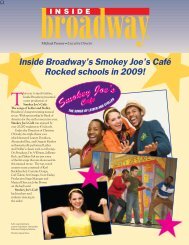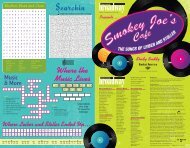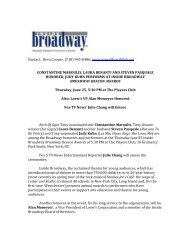Duke Ellington, Sophisticated Ladies - Inside Broadway
Duke Ellington, Sophisticated Ladies - Inside Broadway
Duke Ellington, Sophisticated Ladies - Inside Broadway
You also want an ePaper? Increase the reach of your titles
YUMPU automatically turns print PDFs into web optimized ePapers that Google loves.
Read All About It<br />
During the Harlem Renaissance, there<br />
were two important magazines providing<br />
an outlet for art and literature.<br />
Opportunity, published by the National<br />
Urban League and Crisis a monthly<br />
periodical published by the NAACP,<br />
were dedicated to African American<br />
issues, art and literature. Through their<br />
literary contests they were able to give voice to several<br />
important writers of the day including Countee Cullen and Nora<br />
Zeale Hurston along with publishing the artwork of Aaron<br />
Douglas. Many publishing companies looked to these magazines<br />
to find young Black writers with new<br />
ideas and perspectives which led to<br />
a wider audience.<br />
It Don’t Mean a Thing<br />
if it Ain’t Got That Swing…<br />
The history of swing dancing dates back to the<br />
early 1920’s. During this time dancers discovered the<br />
Charleston and Lindy Hop while dancing to Jazz music.<br />
By the 1930’s the Jitterbug had joined these dances to<br />
form the basis of swing dancing as we know it today.<br />
Swing dancing was a hit with the people, but not with<br />
dance teachers. Dance schools such as The New York<br />
Society of Teachers an Arthur Murray did not begin<br />
teaching these dances until the early 1940’s.<br />
“Take the A Train” is one of <strong>Duke</strong> <strong>Ellington</strong>’s best know<br />
recordings and a great way to get home if you happen to live<br />
uptown. At 31 miles, the “A” train is the longest subway line<br />
in the New York City Transit System and spans from Queens<br />
to Brooklyn to the tip of Manhattan. Opened in 1932, the<br />
“A” was the first subway route operated by New York City as<br />
part of the Independent (IND) subway system and originally<br />
spanned only 12 miles, from Chambers Street in lower Manhattan<br />
to Harlem. As the lyrics state “If you miss the A train,<br />
you’ll find you missed the quickest way to Harlem”.<br />
On Tap<br />
Even though tap dancing has its roots in Irish<br />
step dancing and clogging, it is an original<br />
American art form. Between the 1600’s and<br />
1800’s tap evolved from European step dances<br />
and a variety of African steps that were labeled<br />
“juba” and “ring shout” dances.<br />
After the Civil War, new steps were added<br />
to the tap vocabulary including “stop time”,<br />
“soft shoe” and “time step”. At the turn of<br />
the 21st century, tap gained prominence in<br />
vaudeville with performers such as Bill “Bojangles”<br />
Robinson and John Bubble and later<br />
in film musicals staring such renowned dancers<br />
as Fred Astaire and the Nicholas Brothers. As<br />
the 1950’s approached, tap began to lose its<br />
popularity as dance styles changed and new<br />
dances were introduced. In the 1960’s several<br />
public tap dance events reignited an interest in<br />
what was now considered an art form. Starting<br />
in the 1980’s, tap reappeared on the <strong>Broadway</strong><br />
stage in such musicals as Jelly’s Last Jam, Black<br />
and Blue, The Tap Dance Kid and 42nd Street.<br />
In 1989, Congress designated May 25th as<br />
“National Tap Dance Day”, which is celebrated<br />
by people across the United States.<br />
Art Deco<br />
During the roaring twenties and the<br />
early thirties, Art Deco architecture<br />
was all the rage. Like many styles it<br />
is a combination of different influences<br />
from many sources. You can<br />
easily see the influence of Egyptian<br />
design in Art Deco style which many<br />
attribute to the discovery of King<br />
Tutankhamen’s tomb by English<br />
Egyptologist Howard Carter in 1922.<br />
Other influences include Roman,<br />
Greek and other Middle Eastern<br />
styles. Jewelry, clothing, artwork and<br />
buildings made during the 1920’s<br />
and 30’s often reflect this unique<br />
style, especially here in New York<br />
City. Many apartment buildings have<br />
crown moldings, arched doorways<br />
and feature “Egyptian” style tile<br />
work and statues on the outside and<br />
entryways. The Empire State Building,<br />
Chrysler Building and Radio<br />
City Music Hall are three of the most<br />
famous examples of Art Deco design<br />
here in the city.








